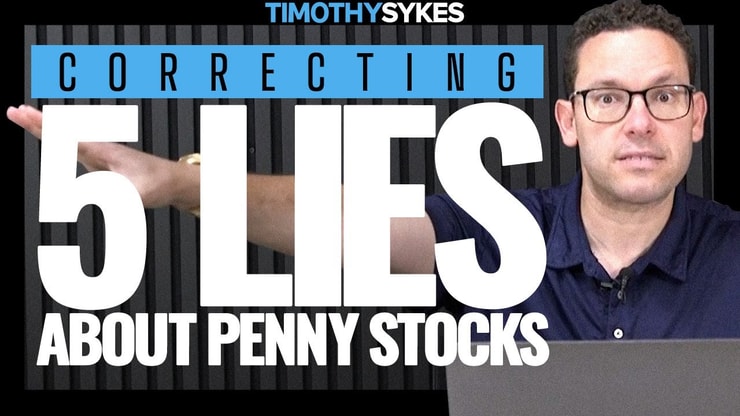Penny stocks in Canada — typically priced under $5 per share — represent a high-risk, high-reward corner of the market. These low-priced shares are usually tied to small-cap or early-stage companies, including those in tech, biotech, mining, and energy. The appeal is obvious: low cost of entry with big upside potential. But they also come with heavy risks — limited liquidity, high volatility, and weaker disclosure requirements.
For Canadian traders, navigating this space takes more than enthusiasm. It takes strategy, discipline, and a willingness to do the work most people skip.
You should read this article because it lays out exactly what Canadian penny stocks are, what makes them risky, and how to trade them smarter.
I’ll answer the following questions:
- What are Canadian penny stocks?
- Why are penny stocks considered risky?
- How do I buy penny stocks in Canada?
- Can you buy Canadian penny stocks on Wealthsimple?
- What factors contribute to the volatility of penny stocks?
- Are there penny stocks on the TSX?
- What are the characteristics of penny stocks?
- What tips and strategies should I consider for investing in penny stocks?
Let’s get to the picks!
Table of Contents
- 1 Top Canadian Penny Stocks to Consider
- 2 What Are Canadian Penny Stocks?
- 3 The Allure of Penny Stocks in Canada
- 4 Risks and Rewards of Penny Stocks
- 5 Pros and Cons of Penny Stocks
- 6 Tips and Strategies for Investing in Penny Stocks
- 6.1 Do Your Research
- 6.2 Diversify Your Portfolio
- 6.3 Set a Budget
- 6.4 Avoid Chasing Hype
- 6.5 Use Limit Orders
- 6.6 Stay Updated
- 6.7 Understand the Risks
- 6.8 Look for Liquidity
- 6.9 Be Skeptical of Promotions
- 6.10 Set Clear Exit Strategies
- 6.11 Stay Informed
- 6.12 Consider the Source
- 6.13 Monitor Regularly
- 6.14 Avoid Overtrading
- 6.15 Stay Calm and Patient
- 7 Where to Buy Canadian Penny Stocks
- 8 Key Takeaways
- 9 Frequently Asked Questions (FAQs)
- 9.1 How Do I Buy Penny Stocks in Canada?
- 9.2 Can You Buy Canadian Penny Stocks on Wealthsimple?
- 9.3 Are There Penny Stocks on The TSX?
- 9.4 What Should You Know About Reporting Penny Stocks in Canada?
- 9.5 Where Can I Find Reliable Examples of Penny Stock Success?
- 9.6 What Are the Chances of Finding Good Penny Stocks in Canada?
- 9.7 How Do Disclaimers Affect Penny Stock Advice?
Top Canadian Penny Stocks to Consider
My top Canadian penny stock picks are:
- NYSE: BB — BlackBerry Limited
- NASDAQ: HIVE — HIVE Digital Technologies
- NASDAQ: TLRY — Tilray, Inc
- NASDAQ: DRUG — Bright Minds Biosciences Inc
- AMEX: CYBN — Cybin Inc
When considering top Canadian penny stocks, investors look for companies with solid fundamentals, such as sustainable debt levels and promising revenue streams. These might include firms involved in the development of new technologies or commodities like gold and copper. The best candidates are often found through a combination of screener tools, expert analysis, and a review of financial data, with a keen eye on industry trends and expectations.
Before you send in your orders, take note: I have NO plans to trade these stocks unless they fit my preferred setups. This is only a watchlist.
The best traders watch more than they trade. That’s what I’m trying to model here. Pay attention to the work that goes in, not the picks that come out.
Sign up for my NO-COST weekly watchlist to get my latest picks!
BlackBerry Limited (NYSE: BB)
My first penny stock pick is BlackBerry Limited (NYSE: BB).
BlackBerry is a classic meme stock. It’s bounced from the ashes of its smartphone business and reinvented itself in cybersecurity and IoT. Recently, shares nearly doubled after stronger-than-expected earnings. But don’t let the headlines fool you — this company is still burning cash, and its long-term fundamentals remain questionable.
Why I’m Watching:
This stock still moves on hype. It’s a former meme runner. If it perks up again on unusual volume, it could offer a short-term setup.
What to Watch For:
- High relative volume
- Breakout over recent resistance
- News catalysts or PR drops
HIVE Digital Technologies (NASDAQ: HIVE)
My second penny stock pick is HIVE Digital Technologies (NASDAQ: HIVE).
HIVE is a crypto-adjacent play, with roots in Bitcoin mining. In a typical penny stock move, it’s tried pivoting into AI — but that part of the business has been a non-starter. Despite flashy slides and projections, the numbers just don’t back it up. The company is also heavily diluting shareholders to fund its operations, and network hashrate competition makes its projections shaky at best.
So why is it on my radar?
Because HIVE still trades with crypto sentiment. When Bitcoin moves, HIVE often follows. That kind of correlation can offer short-term trading setups — even if the fundamentals are garbage.
Trading Notes:
- Watch for sympathy moves when Bitcoin spikes
- Look for high-volume breakouts or failed morning spikes
- Avoid holding — this company loves dilution
More Breaking News
- BTG Stock Drops: Is It Recovery Time?
- Lumentum’s Surge: Analyzing Current Market Moves
- DNN: Stock Moves Higher – What Next?
Tilray, Inc (NASDAQ: TLRY)
My third penny stock pick is Tilray, Inc. (NASDAQ: TLRY).
Tilray just scored a legal win, and cannabis stocks are getting renewed attention thanks to political chatter around federal rescheduling in the U.S. The company’s Q3 earnings are coming up soon… Tilray might be setting up for a bigger run.
Why I’m Watching:
Cannabis stocks can be explosive when momentum hits — but TLRY has failed to sustain rallies before. I’ll watch the price action around earnings and look for any unusual spikes in volume.
Key Levels:
- Break of pre-earnings highs
- Strong multi-day breakout patterns
Bright Minds Biosciences Inc (NASDAQ: DRUG)
My fourth penny stock pick is Bright Minds Biosciences Inc (NASDAQ: DRUG).
DRUG went parabolic in 2024 — we’re talking a 4,000%* move in under a month. And here’s the kicker: it wasn’t even off a breakthrough trial, just speculation. The company even had to put out a press release saying they didn’t know why the stock exploded. Welcome to penny stock land.
Why I’m Watching:
This kind of irrational run is exactly the kind of move I love to study. I’m not chasing strength here — I’m watching for panic. This could offer ideal dip buy or morning panic patterns for experienced traders.
Setups I Like:
- Morning panics for dip buys
- Multiday bounce after heavy fade
Cybin Inc (AMEX: CYBN)
My fifth penny stock pick is Cybin Inc (AMEX: CYBN).
Cybin focuses on psychedelic-based therapies for mental health. The biotech space is speculative by nature — that’s without CYBN’s massive analyst price target suggesting 900%* upside. Be skeptical — those kinds of targets often have zero connection to reality. But price movement matters more than opinion.
Why I’m Watching:
Biotechs with low floats and catalysts can explode — especially when chat rooms amplify them. If positive trial updates come through or volume spikes, I’ll watch for sympathy momentum in the sector.
What I Want to See:
- Pre-market gapping on news
- Unusual volume and float rotation
- Sector sympathy moves
* Past performance isn’t indicative of future results.
What Are Canadian Penny Stocks?
Canadian penny stocks are low-priced shares — usually under $5 — often tied to small-cap companies. Many trade on the TSX Venture Exchange or over-the-counter markets. They attract traders for their affordability and explosive potential, but you need to dig into the fundamentals: cash on hand, revenue, debt, and industry momentum all matter.
Be selective when you trade penny stocks. Don’t confuse their cheap price with value.
Characteristics of Penny Stocks
Penny stocks typically have:
- Low share price and market cap
- Thin trading volume
- Limited regulatory oversight
- High risk of manipulation
You might find them on the TSXV, OTC markets, or buried under the radar on the TSX. The ones on this watchlist also trade on U.S. exchanges.
Overview of the Canadian Penny Stock Market
Canada’s penny stock market includes traditional sectors like mining and oil, as well as emerging plays in tech and biotech. Many trade outside major exchanges, making due diligence even more critical.
Resource names — gold, copper, uranium — tend to dominate the space. That can be an edge if you know what to look for, or a trap if you chase headlines.
The Canadian penny stock market is not just about tech and innovation; it also offers opportunities in more traditional sectors like oil. With the global energy landscape in flux, penny oil stocks in Canada present a unique, albeit speculative, investment avenue. These stocks can be particularly sensitive to geopolitical events and changes in oil prices, making them a volatile but potentially rewarding play. For those interested in the intersection of energy and equity, here’s a look at the top penny oil stocks in Canada that are currently standing out in the market.
The Allure of Penny Stocks in Canada
Let’s be clear: I don’t invest in penny stocks — I trade them.
What draws me to penny stocks is the volatility. These stocks move fast. When a sector heats up or a news catalyst hits, the right stock can spike 100% or more in a day. That kind of opportunity doesn’t exist in large caps.
But it’s not about guessing. I teach my students how to identify these moves, how to react with discipline, and how to protect capital when things go south — because they often do.
Reddit, a hub for such discussions, provides a wealth of insights and tips from a diverse range of perspectives. When considering penny stocks, tapping into the collective wisdom of Reddit users can uncover hidden gems and provide a pulse on market sentiment. For a snapshot of the best penny stocks in Canada according to Reddit users, you can explore this compilation that captures the stocks making waves within the community.
The Secret Behind Canadian Penny Stock Resilience
Canadian penny stocks have shown resilience due to global demand for natural resources, a stable banking system, and increasing activity in speculative sectors like psychedelics and green tech.
But don’t let that fool you into thinking they’re “safe.” These stocks can crash just as quickly as they run.
I don’t care if the company is “promising” — I care about price action. 99% of penny stocks are scams, and will eventually be worth nothing.
Factors Contributing to the Stability and Growth of Penny Stocks in Canada
There are legitimate growth factors at play — resource-rich sectors, innovation hubs, and market expansion. But that doesn’t change the fundamental truth:
Penny stocks are for trading, not investing.
Use volatility to your advantage. When you see the right pattern and volume confirms it, you trade it. Then you get out.
Risks and Rewards of Penny Stocks
The rewards can be massive — I’ve seen 1,000%+ intraday runners. But the risks are just as big. Many penny stocks fade 90% or more after a single spike.
That’s why I trade them. I don’t marry these stocks. I treat them like ticking time bombs. You study the chart, plan your entry and exit, and respect your risk.
Understanding the risks and rewards of penny stocks is crucial, and part of that is knowing the rules that govern trading. In Canada, the Pattern Day Trader (PDT) rule, familiar to U.S. traders, does not apply, offering a different trading dynamic. This absence allows for more flexibility in trading activities but does not diminish the need for a disciplined approach. For Canadian traders, it’s essential to understand the regulatory environment to navigate these waters effectively. Learn more about how the PDT rule applies in Canada and what that means for your trading strategy.
Why Are Penny Stocks Considered Risky?
They’re risky because of:
- Low liquidity
- Lack of transparency
- Easy targets for pump-and-dump scams
But if you understand those risks and know what patterns to look for, that’s where opportunity lives.
Factors That Contribute to the Volatility of Penny Stocks
- Low float (small supply of shares)
- Speculation and hype
- News catalysts or rumors
- Lack of institutional control
These same factors that scare off investors are exactly what attract traders like me. Volatility is the lifeblood of penny stock trading.
Pros and Cons of Penny Stocks
Let’s break it down…
Pros:
- Low price means smaller capital requirement
- Big intraday price swings = big opportunity
- Often tied to emerging sectors like biotech or crypto
Cons:
- High risk of total loss
- Price manipulation is common
- Most companies will fail long term
Are Penny Stocks Worth It?
Let’s phrase this the way most investors frame it: Are penny stocks worth investing in?
My answer? No. I don’t invest in penny stocks — ever.
Why? Because they’re too volatile, too speculative, and too often propped up by hype.
But are penny stocks worth trading? Absolutely — if you know what you’re doing.
That’s where I focus: short-term setups, risk management, and reacting to price action. That’s the strategy I teach in my Trading Challenge.
Tips and Strategies for Investing in Penny Stocks
Once again —
I don’t recommend investing in penny stocks.
Instead, I trade them. I look for repeatable patterns, analyze volume, manage risk, and exit fast. That’s how I’ve stayed profitable for over two decades — and helped dozens of students hit six and seven figures.
But if you’re exploring this space, here are some tips you can apply to trading penny stocks:
Do Your Research
Study the company, the sector, the chart. But most of all — study the price action.
Diversify Your Portfolio
Don’t put all your cash into one ticker. Better yet, watch more than you trade.
Set a Budget
Only risk what you can afford to lose. Treat every penny stock trade like it could go to zero — because it might.
Avoid Chasing Hype
If you’re buying because Reddit said so, you’re late. Wait for the setup to form and volume to confirm.
Use Limit Orders
Market orders with low volume? That’s how you get burned. Control your entry and exit.
Stay Updated
Most penny stocks fail. Accept that, and adjust your mindset. You’re not investing in a future — you’re trading a moment.
Understand the Risks
Before diving into penny stocks, make sure you fully understand the risks. These can include everything from liquidity issues to the potential for fraud. Being aware of these risks can help you navigate the penny stock market more safely and effectively.
Look for Liquidity
Liquidity is a critical factor in penny stock trading. Look for stocks with higher trading volumes, which can make it easier to enter and exit positions. Low liquidity can lead to price manipulation and difficulty selling your stock.
Be Skeptical of Promotions
Penny stocks are often the subject of promotions and hype. Approach these with skepticism and do your due diligence to ensure you’re not falling for a pump-and-dump scheme.
Set Clear Exit Strategies
Having clear exit strategies in place is vital. Decide in advance at what price point you’ll take profits or cut losses, and stick to your plan. This discipline can help you avoid emotional decision-making and protect your capital.
Stay Informed
Staying informed is key to success in penny stock trading. Keep up with financial news, company announcements, and market trends to make educated decisions.
Consider the Source
When researching penny stocks, consider the source of the information. Rely on reputable news outlets and financial statements rather than promotional materials or unverified online forums.
Monitor Regularly
Penny stocks require regular monitoring due to their volatility. Keep a close eye on your investments and the market conditions to react quickly to any changes.
Avoid Overtrading
Overtrading can lead to excessive fees and can cloud your investment strategy. Be selective with your trades and focus on quality over quantity.
Stay Calm and Patient
Patience is a virtue in the penny stock market. Don’t let short-term fluctuations lead to rash decisions. Stay calm and focused on your long-term strategy.
Where to Buy Canadian Penny Stocks
To trade Canadian penny stocks, you’ll need a brokerage that offers access to the TSX Venture Exchange or OTC markets. Platforms like Questrade, TD Direct Investing, and Interactive Brokers are common options.
Choose a broker that supports limit orders, has real-time data, and charges reasonable fees — because costs matter when you’re trading low-priced, high-risk stocks.
Key Takeaways
Canadian penny stocks are volatile, speculative, and high-risk — perfect for trading, not investing.
If you’re disciplined, prepared, and focused on short-term setups, these stocks can offer explosive opportunities. But don’t get greedy, and don’t fall in love with any ticker.
Trading isn’t rocket science. It’s a skill you build and work on like any other. Trading has changed my life, and I think this way of life should be open to more people…
I’ve built my Trading Challenge to pass on the things I had to learn for myself. It’s the kind of community that I wish I had when I was starting out.
We don’t accept everyone. If you’re up for the challenge — I want to hear from you.
Apply to the Trading Challenge here.
Trading is a battlefield. The more knowledge you have, the better prepared you’ll be.
What Canadian penny stocks are on your watchlist? Let me know in the comments — I love hearing from my readers!
Frequently Asked Questions (FAQs)
How Do I Buy Penny Stocks in Canada?
Buying penny stocks in Canada typically involves opening a brokerage account with a firm that provides access to the TSX, Nasdaq, or OTC markets. Look for brokerages that offer low fees and robust trading platforms to maximize your investment potential.
Can You Buy Canadian Penny Stocks on Wealthsimple?
You can buy penny stocks on Wealthsimple Trade if they’re listed on the major American and Canadian exchanges, such as the Nasdaq, New York Stock Exchange (NYSE), and Toronto Stock Exchange (TSX). Wealthsimple Trade doesn’t let you trade OTC stocks.
Are There Penny Stocks on The TSX?
While the TSX is known for more established companies, it does list some stocks that could be considered penny stocks. These are usually found in the TSX Venture Exchange, which features smaller or emerging companies.
What Should You Know About Reporting Penny Stocks in Canada?
When reporting on penny stocks in Canada, content creators must ensure that the information on their page is accurate and reliable. For example, details about securities and money invested should be based on verifiable examples. It’s also advised to provide a disclaimer noting that such content isn’t professional investment advice.
Where Can I Find Reliable Examples of Penny Stock Success?
For those researching penny stocks, look for pages that offer comprehensive reporting on securities. Ensure that these resources provide concrete examples of penny stock trades and not just theoretical answers. It’s crucial to heed the advice given by experienced traders and to be aware of the disclaimer that trading involves risks.
What Are the Chances of Finding Good Penny Stocks in Canada?
The chances of finding promising penny stocks can be improved by studying historical contracts and board decisions of companies. Jobs in financial analysis may also provide insights into potential penny stock opportunities. Remember, penny stock investments should be approached with caution and not solely based on advice from unverified sources.
How Do Disclaimers Affect Penny Stock Advice?
Disclaimers are essential in the realm of penny stocks as they clarify that advice given is not a guarantee of money or success. They remind investors that every example provided is unique and that the chances of replicating such success require careful consideration of the securities and contracts involved.










Leave a reply